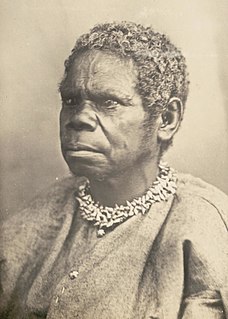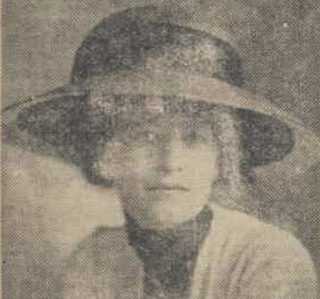Related Research Articles

Hobart is the capital and most populous city of the Australian island state of Tasmania. Home to almost half of all Tasmanians, it is the least-populated Australian state capital city, and second-smallest if territories are taken into account, before Darwin, Northern Territory. Hobart is located in Tasmania's south-east on the estuary of the River Derwent, making it the most southern of Australia's capital cities. Its skyline is dominated by the 1,271-metre (4,170 ft) kunanyi/Mount Wellington, and its harbour forms the second-deepest natural port in the world, with much of the city's waterfront consisting of reclaimed land. The metropolitan area is often referred to as Greater Hobart, to differentiate it from the City of Hobart, one of the five local government areas that cover the city. It has a mild maritime climate.

Truganini was an Aboriginal Tasmanian woman. She was one of the last native speakers of the Tasmanian languages and one of the last individuals solely of Aboriginal Tasmanian descent.

John Glover was an English-born artist. In later life he migrated to Van Diemen’s Land and became a pastoralist during the early colonial period. He has been dubbed "the father of Australian landscape painting."

Sir James Willson Agnew was an Irish-born Australian politician, who was Premier of Tasmania from 1886 to 1887.

Thomas Bock was an English-Australian artist and an early adopter of photography in Australia. Born in England he was sentenced to transportation in 1823. After gaining his freedom he set himself up as one of Australia's first professional artists and became well known for his portraits of colonists. As early as 1843 he began taking daguerreotypes in Hobart and became one of the earliest commercial photographers in Australia.

Benjamin Duterrau was an English painter, etcher, engraver, sculptor and art lecturer who emigrated to Tasmania. There he became known for his images of Indigenous people and Australian history paintings.
Lenah Valley is a suburb of Hobart, Tasmania. It is situated in the foothills of Mount Wellington, north of the CBD between Mount Stuart, New Town and the City of Glenorchy.
Leonard Rodway was an English-born Australian dentist and botanist.

The Royal Society of Tasmania (RST) was formed in 1843. It was the first Royal Society outside the United Kingdom, and its mission is the advancement of knowledge.
The Queen Victoria Museum and Art Gallery (QVMAG) is a museum located in Launceston, Tasmania, Australia. The QVMAG is the largest museum in Australia not located in a capital city.

The Tasmanian Museum and Art Gallery (TMAG) is a museum located in Hobart, Tasmania. The museum was established in 1846, by the Royal Society of Tasmania, the oldest Royal Society outside England. The TMAG receives 400,000 visitors annually.

William Charles Piguenit was an Australian landscape painter.
The Museum of Old and New Art (MONA) is an art museum located within the Moorilla winery on the Berriedale peninsula in Hobart, Tasmania, Australia. It is the largest privately funded museum in the Southern Hemisphere. MONA houses ancient, modern and contemporary art from the David Walsh collection. Noted for its central themes of sex and death, the museum has been described by Walsh as a "subversive adult Disneyland".

Franklin Square is an oak-lined public space in Central Hobart, Tasmania, Australia. It is named after Sir John Franklin (1786-1847), the Arctic explorer and former Lieutenant-Governor of Van Diemen's Land ; the centrepiece of the park is a statue of Franklin, with an epitaph by Alfred, Lord Tennyson.

Florence Aline Rodway was an Australian artist best known for her portraits. Born in the Tasmanian city of Hobart, she was the second of six children to Leonard Rodway and Louisa Susan, née Phillips. She studied painting at the Hobart Technical College ; after two years her work was sent to London, and she was awarded a three-year scholarship to study painting at the Royal Academy of Arts, London. She is best known for having painted portraits of notable figures in Australian history, including Dame Nellie Melba, William Bridges, J. F. Archibald and Henry Lawson.
The Tasmanian Heritage Register is the statutory heritage register of the Australian state of Tasmania. It is defined as a list of areas currently identified as having historic cultural heritage importance to Tasmania as a whole. The Register is kept by the Tasmanian Heritage Council within the meaning of the Tasmanian Historic Cultural Heritage Act 1995. It encompasses in addition the Heritage Register of the Tasmanian branch of the National Trust of Australia, which was merged into the Tasmanian Heritage Register. The enforcement of the heritage's requirements is managed by Heritage Tasmania.
Frank Styant Browne, also known as Styant Browne, was an Australian pharmacist, artist, photographer and X-ray pioneer from Tasmania.
Lola Greeno is an artist, curator and arts worker of Aboriginal descent. She studied a Bachelor of Fine Arts at the University of Tasmania in Launceston, finishing her degree in 1997.
Dorothy Kate Stoner was an Australian artist and teacher. She was known for her pastels and modernistic paintings.
The Lady Franklin Gallery and Ancanthe Park is a historic sandstone museum and parkland in Lenah Valley, Tasmania, Australia. When it opened on 26 October 1843, it became the first privately funded museum in Australia.
References
- ↑ "Louisa Swan". Tasmanian Government - Honour Roll of Women. Retrieved 4 April 2022.
- ↑ "History of the Lady Franklin Gallery". The Art Society of Tasmania. Retrieved 4 April 2022.
- ↑ "ART SOCIETY OF TASMANIA". Centre for Tasmanian Historical Studies. Retrieved 4 April 2022.
- ↑ Rääbus, Carol (17 October 2017). "Lady Franklin Gallery: Why there's a Greek-style building at the back of Lenah Valley". abc.net.au. Retrieved 4 April 2022.
- ↑ "Re-opening of the Lady Franklin Museum (1949)". Libraries Tasmania. 27 March 2020. Retrieved 4 April 2022.